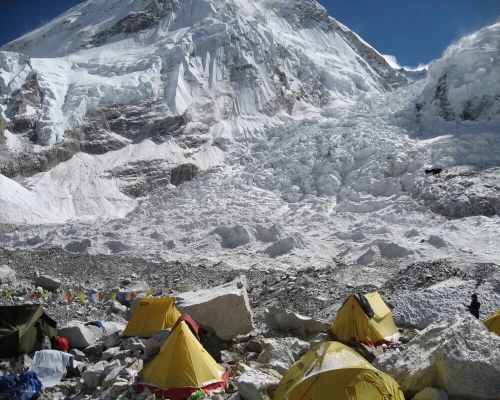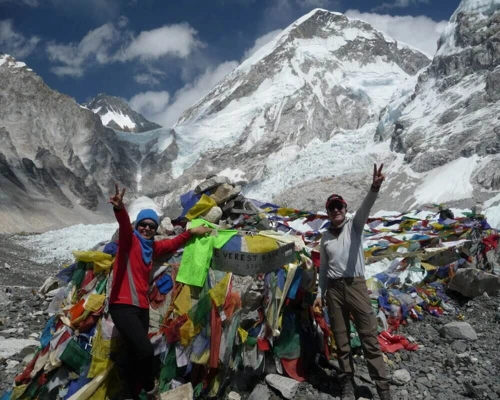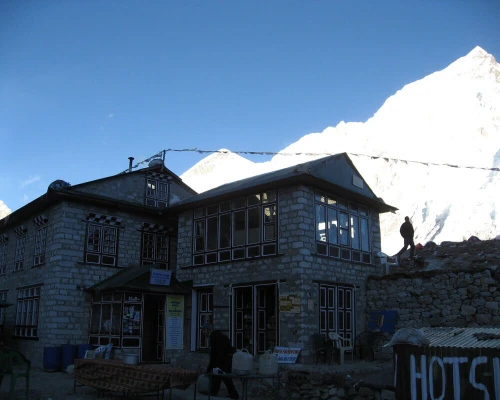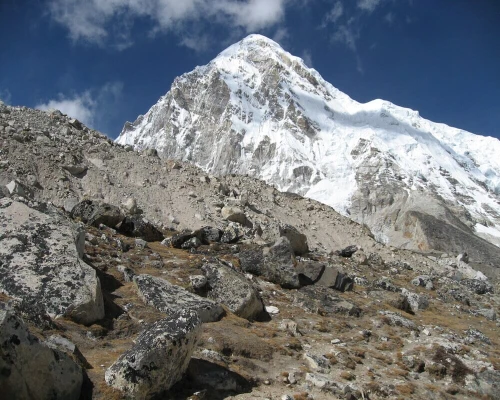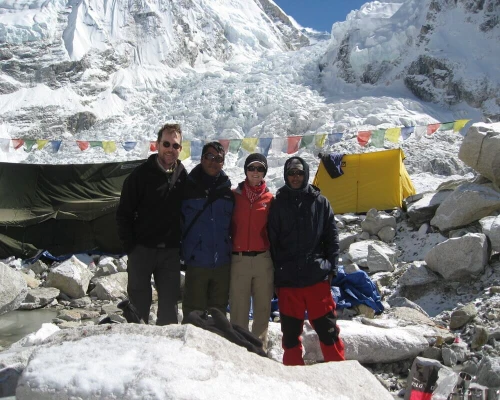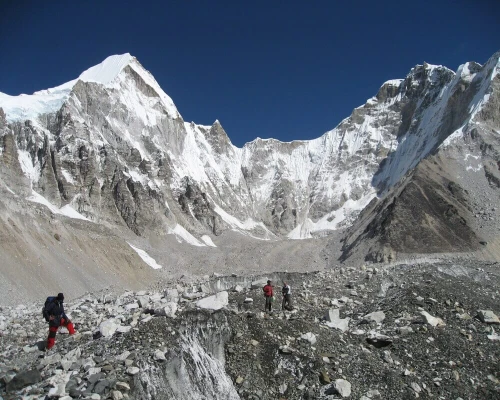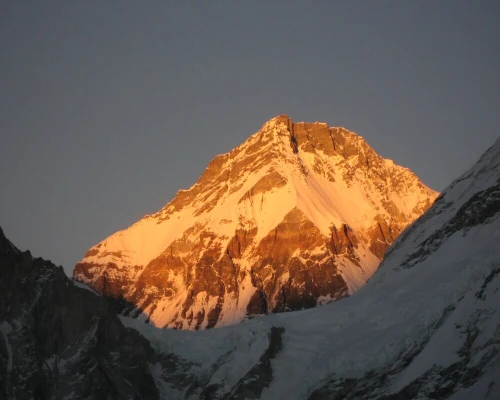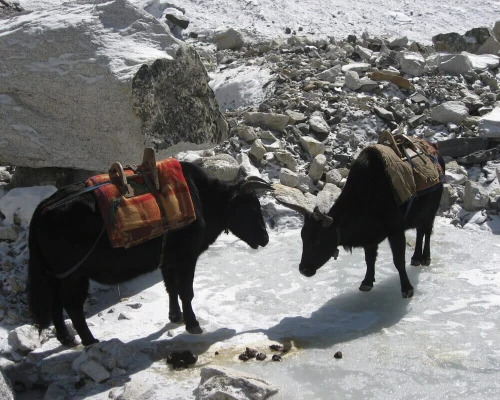Everest Base Camp trek demonstrates the majesty of the Khumbu region. Amidst such spectacularly impressive giants as Lhotse (8,516 m/27,939 ft) to the east, Nuptse (7,861 m/25759 ft) to the south east, and Ama Dablam (6,812 m/22,349 ft) to the south, the Base Camp trek reveals nature's rich bounty. The original starting point for the assault on the highest summit in the world in 1953 is now the hub of exploration and action in the Himalayas. Get to Gorak Shep (5140 m/16863 ft) and Kala Patthar (5550 m/18208 ft) and enjoy a magnificent view of Everest (8848 m/29028 ft) and other highest peaks of the Himalayas. The tranquil hike and great sense of fulfillment produce a mysterious feeling of admiration, which leaves an unforgettable and complete impression.
The captivating characteristics of Sherpa communities are their colorful prayer flags, ancient stone dwellings, and warm-hearted locals. Gain the real taste of their culture at the lively Mani Rimdu festival in the Tengboche Monastery, a colorful display of masked dances, religious ceremonies, and prayers for success. The trip through the Himalayas is a captivating journey that intertwines breathtaking scenery with diverse wildlife. Meet the charismatic snow leopard, the Himalayan Tahr, and colorful birds such as the Himalayan Monal. The path goes through charming towns, majestic forests of alpine trees, and surprising glacier landscapes that make nature's artwork mesmerizing. The start of this charming journey is marked by a comfortable flight from Kathmandu to Lukla that takes about 40 minutes. Contrarily, during the vibrant seasons of spring and fall, a truly thrilling drive from Kathmandu to Ramechhap will send adventurous souls on a heart-thumping ride. The narrative continues with an exhilarating flight to Lukla, which sets the tone for the entire expedition.
Set out from bustling Kathmandu at an elevation of 1360 meterson an exciting 16 days trip. Take in the depths of culture on day two with fascinating sightseeing. On day three, the journey starts with an amazing flight to Lukla (2845 m/9334 ft) and then a hike on to Phakding (2652 m/8700 ft). On the fourth day, trek from Phakding (2652 m/8700 ft) to Namche Bazaar (3440 m/11286 ft), providing time for peaceful acclimatization on the fifth day. The sixth day includes an enthralling 7-hour hike to Tengboche (3855 m/12647ft). After an acclimatization day on the eighth day, go to Dingboche (4,360 m/14304 ft) on the seventh day. Walk from Dingboche to the high sanctuary of Lobuche (4910 m/16108 ft) on day nine. A strenuous but worthwhile nine-hour hike from Lobuche to Gorak Shep (5140 m/16863 feet) and the trek's pinnacle (5364 m/17598 feet) is part of the tenth day's itinerary. Arriving at the summit of Kala Patthar (5550 m/18208 ft) on the eleventh day, you will then continue to the peaceful Lobuche Base Camp (5400 m/17716 ft). Acclimatize on the twelfth day and summit at (5760 m/18897 ft) on the thirteenth. On day fourteen, descend to Pheriche (4,371 m or 14,340 ft); on day fifteen, hike to Tengboche; and end with a picturesque flight back to Kathmandu.
Venture to the Everest Base Camp and step into a snowy wonderland of majestic peaks.
- A journey with the company of peaks like Ama Dablam, Nuptse, Lhotse, Makalu, and others
- A walk into the lovely settlements of the Sherpas
- Encounters of graceful monasteries in great heights
- Dense and rich wilderness along with the habitat of rare wildlife
- The revelation of the true beauty of Everest.
- Venturing through the extraordinary wilderness
What exciting prospects await those embarking on the Everest Base Camp adventure?
Explorers will be encountered with new worlds of adventurous possibilities when you set out on this journey. The exploration starts by walking along a beautiful road in an eco-friendly environment, and in later stages, it goes through the rough plains, which need to be pushed through beyond physical and mental limits. For mountaineers, this trek is the ultimate payback; you get to see the glorious panorama and well-known Mt. Everest up close. Travelers have an opportunity to explore culturally diverse old monasteries, among the world-famous ones, including the Tengboche Monastery. The journey ends with every step, with the feet settling on the ground of Mount Everest itself.
Among these is the assuranceof an experience that will rejuvenate and enlarge the mind. The flora, the native wildlife, the companionship of other trekkers, and the cultural immersion all contribute to making this an expedition that you will never forget.
A Cultural Odyssey on the Base Camp Adventure
In the heart of Kathmandu, where vendors bellow and temples soar in the harmony of colors and traditions, it is here that the expedition begins. Unravel the elaborate cultural heritage of the majestic Durbar Square in Kathmandu, where life-size carvings and palaces expose a vision of the past and a history of bygone kings. Listen to the melody of the religious rites by the Bagmati River and lose yourself in the chanting that is Pashupatinath, a famous Hindu temple. Upon your arrival in Kathmandu, anticipate a warm welcome complemented
The Tengboche Monastery, which is designated as a serene beacon of tranquility among the untamed grandeur of the Himalayas, welcomes you to the start of an amazing journey. Since the monastery is on a hill, it offers breathtaking scenery of Mount Everest and peace that facilitates meditation. Be part of the soulful integration of spirituality and nature in the daily monks' rituals and experience the healing fragrance of the juniper smoking cones.
Tengboche Monastery, located in Ama Dablam's shadow, develops into a cultural refuge where age-old customs are upheld. Talk with the monks, discover more about their lifestyle, and take in the age-old dance rituals that have been passed down through the ages. Nestled at 3,867 meters above sea level on the trail, the monastery offers a stunning view of some of the world's highest peaks, including Everest, in addition to its profound Buddhist origins. Tengboche Monastery is a wonderful fusion of natural beauty and cultural history in the heart of the Himalayas. Trekkers will have an unparalleled experience thanks to its colorful frescoes, ancient architecture, and the cultural richness of the Mani Rimdu festival.
Treading the Unexplored Path
Trekking to Everest Base Camp is an adventure into uncharted territory where each step offers a unique combination of challenge and joy. Trekkers follow rough paths through a variety of environments, from verdant woods to stony terrain, all while keeping a close eye on the towering Himalayan peaks. With each climb comes greater anticipation as one approaches Tengboche Monastery, a hidden treasure along the route and a spiritual retreat. The uncharted route to Base Camp opens up amid peace and cultural diversity, offering not only a physical victory but also a life-changing journey where the heart finds comfort in the vastness of the mountains and the peace of the unknown.
The Magnetic Pull of Peaks on the Trail
The trail meandering towards Everest base camp offers an amazing view of the commanding profiles of Lhotse (8,516m/27,940ft), Nuptse (7,861m/25,791ft), Ama Dablam (6,812m/22,349ft), and Pumori (7,161m/23,494ft), while your eyes naturally latch onto the majestic presence of Mount Everest. As you ascend, these massive peaks will watch over you with a steady and inspirational gaze.
Every peak tells a story of perseverance and grandeur, from the well-known Ama Dablam (6812 m/22349 ft) to the formidable Pumori (7,161 m/23,494 ft). As you answer the call, the trek offers a symphony of spectacular sights and a deep connection with these imposing giants. Every peak adds poetry to the story of achievement and discovery, making the trip more than just a climb but an exploration of the core of the Himalayan draw.
The breathtaking biodiversity of the Sagarmatha National Park
Hikers know the existence of plants and animals that survive uniquely in this tough but inviting area when they move along the road. At higher elevations, some hardy alpine ecological communities linger on the rocky terrain with frequency, but at lower elevations, there are lush rhododendron woodlands. Wildlife enthusiasts can try their luck at spotting pheasants, rare snow leopards, and Himalayan Thar roaming about. The awesome biodiversity proves to serve as a natural monument to nature’s courage against all odds as the hiking journey progresses. The World Heritage status of the climb to Everest Base Camp amplifies both the diversity of lives that exist undeterred by the shadows of these mountains and the grandeur of the Himalayas. It turns the journey into a unique odyssey that goes beyond just visual splendor; it adds a new facet of amazement to the expedition.
Delving into Spiritual Depths at Dawa Choling Gompa and the Enchanting Monkey Temple
The Dawa Choling Gompa and the amazing Monkey Temple are two of the most notable destinations to seek spiritual enrichment that are close to the serenity of the Khumbu locality and the beatific beauty and cultural value of Kathmandu. Visitors can roam into the spiritual realms these spots offer as they embark on this journey of calmness and wisdom.
Dawa Choling Gompa (Tengboche monastery), a Tibetan Buddhist monastery, reveals the peaceful and spiritual atmosphere. Its medieval walls are vibrating with the prayers of monks, and its surrounding area serves as one’s peace retreat. Realize the centuries-old history of Dawa Choling Gompa. Know more about the delicate architecture, which has rainbow prayer flags and symbols that narrate the stories of inner devotion and cultural legacy. Learn the age-old meditative practices. Discover the way of mindfulness or inner peace, and afterwards, Dawa Choling Gompa will provide you with such a place.
It is called "Monkey Temple" by locals. Swayambhunath Temple is a holy place that is unique in that it blends the gods and monkeys in a spiritual way. The temple is not only religiously significant, but its neutrality and cultural integration add to the magic around it. Know the myths and traditions relating to the construction of the Monkey Temple to understand its spiritual background. Every hidden corner of the temple is buzzing with ancient stories, from the Hindu gods down to the local folklore. Take advantage of the company the local monkeys offer you. As they roam wildly through the architectural wonder, make sure to observe them as they exhibit captivating and dynamic behaviors. Get to know the role of monkeys in local myths and the symbolism that holds for different religious systems in a multitude of spiritual practices.
The route's unmatched natural ambience
The excursion to the base camp of Mount Everest gives distinctly an unparalleled nature ambience that fascinates one’s soul, and it is a transformative journey of the heart to the Himalayas. The breath-taking views of Everest (8,848 m/29,029 ft), Nuptse (7,861 m/25,791 ft), and Lhotse (8,516 m/27,940 ft) at Kalapathar (5,545 m/18192 ft). In the morning, the sky reflects the colors of the mountains, providing a stunning landscape. The walk, which is now an energy of resolve and dreams, is in the fresh air of the camp, with the peaks as a background and the Khumbu Icefall in the backdrop.
The trail takes you through the ancient Swayambhunath Stupa in the Kathmandu Valley and travels towards the highest point of the Everest region. The ascent to the top of the stupa makes the soul connect to the two spiritual streams of Hinduism and Buddhism through the panoramic view of the Kathmandu valley. Trekking has a variety of components that become a spiritual expedition. Every step on the path is a way to acquire the serenity of nature forever, changing the adventurer’s heart and mind. A trip to Nepal would be incomplete without visiting Pashupatinath Temple, a UNESCO World Heritage Site. This difficult spot, Lukla Airport, sets the stage for the lifelong experience ahead. Lukla town is full of life and vigor that bring together local communities and hikers. Situated at the highest point on earth, the Everest View Hotel is made to coincide with the luxurious escape accompanied by the site of Everest and its companion peaks. In this place, the traditions of Sherpa are displayed in the space where cultural values are kept. This is the best opportunity to blend luxury and cultural immersion together.
Kala Patthar vistas reveal majestic horizons.
While on an unforgettable excursion to the wondrous Everest Base Camp, Kalapatthar, or literally Black Rocks, stands out as a crucial highlight, providing an awe-inspiring panorama that demonstrates how grand and awesome the Himalayas are. A dispersed perspective reveals all these spectacles, lavishly of snow-capped peaks, winding trails, and the panorama of nature's materialization. Ama Dablam (6,812 m/22,349 ft), Lhotse (8,516 m/27,940 ft), Nuptse (7,861 m/25,791 ft), and Everest (8,848 m/29,029 ft) grace the horizon, embodying the adventurer's spirit. Pumori (7,161m/23,494ft), Thamserku (6,623m/21,729ft), Kangtega (6,782m/22,251ft), and Cho Oyu (8,188m/26,864ft) add to the magnificent spectacle against the Himalayan sky, forever capturing nature's magnificence.
The stunning panorama available from this perspective gives you a vivid picture at every step, and the enduring impressions of the beauty of the Everest region stay forever in the background of your heart and soul. With a mixture of Mount Everest's sheer enormity and the modest allure of the surrounding landscapes, Kalapathar portrays the natural wonder center of the journey of those looking to not just witness the unmatched grandeur of the Himalayas but also be a part of it.
Everest Base Camp (5364 m/17598 ft), offering untainted beauty, is not a scenic point; it's an experience. Scaling the base camp evokes an indescribable euphoria, an emotion that words can barely capture. Standing at the foot of the mightiest peak fills you with a profound sense of pride. At the bottom, looking up at the summit, a wave of feelings assaults the senses. The pride, the lighthouse in the middle of the ocean, shows the way traveled and the hurdles overcome.It is the experience of triumph that resonates through every cell, a testimony of the ordeal undergone and perseverance that drove you to this success.
Unforgettable side trip bliss to Tengboche monastery
Tengboche monastery, at 3,867 m above sea level, offers fantastic views of the Himalayan peaks, including Mount Everest (8,848 m/29,029 ft), Ama Dablam (6,812 m/22,349 ft), and Lhotse (8,516 m/27,940 ft). Tucked between the arms of the tall mountains of the Himalayan range, Tengboche Monastery whispers its religious mystique to you. Be a witness to the grand fabric that is Tibetan Buddhism by experiencing monks attending to their daily routines and their voices being heard as they pray beside the snow-capped mountains. Be speechless at the magnificent architecture of the monastery, which has survived through centuries of craftsmanship and dedication. Here, surrounded by tranquility and the invigorating beauty of nature, you'll find peace and wisdom on a journey that is both spiritual and thrilling.
Examining the main ideas of a 15 day cost and itinerary for the Everest base camp trek
Our team of seasoned Sherpa experts has meticulously crafted our 15 day cost and itinerary. Armed with years of intimate knowledge of the Khumbu region's culture, terrain intricacies, captivating landscapes, and the ability to navigate unforeseen circumstances, our Sherpa team ensures an expedition like no other. Yet, we celebrate flexibility and gladly tailor this itinerary to your unique preferences and special requirements, whether you're a solo adventurer, a part of a group, a family, or a couple from $1700 with 15% discount offer for limited time. Our commitment is to make your experience personalized and extraordinary.
For optimal altitude acclimatization and a deeper exploration of the Solukhumbu region, we recommend adding days to the climb rather than subtracting. At Nepal Nomad Trekking Pvt. Ltd., your happiness, satisfaction, and safety are our utmost priorities, ensuring that your journey is not only memorable but also entirely tailored to your needs.




